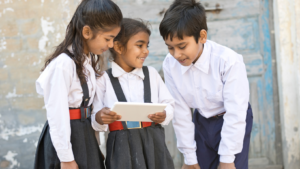In the digital age, it’s become increasingly important for kids to be tech-savvy. But being able to navigate a smartphone or play video games isn’t enough.
So, let’s dive into the digital realm and discover how we can help our children become digitally literate.
Digital Literacy for Kids
What Is Digital Literacy?
Digital literacy for kids, in essence, denotes individuals’ capability to find, analyze, utilize, and create content employing digital technology. It’s not limited to a singular skill or technology, but a conglomeration of abilities that allow kids to engage actively with the digital world. These abilities involve understanding how digital devices function, using them effectively, employing software and apps, and knowing the dynamics of the internet and social media. For instance, children might make use of these skills while researching for an online school project, which can entail verifying facts, discerning between reliable and unreliable sources, and presenting information logically and effectively.

The significance of digital literacy for kids remains pivotal in this tech-centric era. Its importance spreads across various aspects of children’s lives, from education to safety, communication, and even entertainment. Firstly, digitized education systems necessitate that children comprehend and engage with digital resources. They’re often required to research online, submit homework through digital platforms, or participate in virtual classes.
In a world increasingly dominated by technology, digital literacy for kids plays an integral role in kids’ lives. Two core elements define this concept: Technical Skills and Critical Thinking Online.
Technical Skills
Technical skills emerge as the bedrock of digital literacy for kids. They pertain to the use of digital tools, thereby electing Competency as their cornerstone. This spans from basic computing such as keyboard skills and surfing the internet, to more complex tasks like operating software and learning programming languages. For example, a digitally literate child can create a presentation on PowerPoint, carry out research on Google, and even use a coding platform like Scratch to develop a simple game.

Kids with deserved technical skills navigate their digital world confidently. They aren’t bystanders in the tech realm; rather, they take on an active role, utilizing technology to enrich their lives. In education, this translates to a smoother interaction with e-learning platforms, while in entertainment, it equips them to use games and apps responsibly.
Critical Thinking Online reflects the second crucial component of digital literacy for kids. At its core, it’s the ability to evaluate information, discerning fact from fiction. Owing to the Internet’s vast nature, it hosts a wealth of information, but not all of it holds reliability. Alert, digitally literate children distinguish reputable sources from untrustworthy ones, filtering out fake news.

The Critical Thinking aspect also envelops online safety awareness. Kids with honed abilities in this sector understand the risks and responsibilities associated with online interactions. They know not to reveal personal information to strangers, recognize potential cyber threats, and are aware of the consequences of cyberbullying. An illustration of this strategic thinking would be a child who checks for a lock symbol in a web browser before entering any sensitive information.
Closing Remarks
Digital literacy for kids is a vital skill. It’s not just about knowing how to use a device but understanding online safety, identifying reliable information, and honing technical skills. It’s a journey that begins in preschool and evolves as they grow, with challenges such as tech access and screen time balance to consider. Parents and educators have a wealth of resources at their disposal, from apps like Code.org and Khan Academy to websites like BBC’s Bitesize. Monitoring tools like Qustodio and Net Nanny help keep kids safe online, while courses from tech giants and workshops at local libraries and schools further enrich their digital education. With the right tools and guidance, children can navigate the digital world confidently and responsibly.
